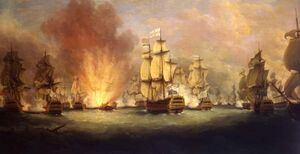Naval Battle of Pondecherry
The Naval Battle of Pondecherry (20 October 1821) was a naval engagement between the Royal Navy against the combined fleets of the Aurucolian and the Sikh Navies as part of the Sikh and Aurucolian War during the 1821 Maharashtra-Andhrapradesh Campaign. As part of the plan to destroy Lucian hold in Indiae, the plan would call for the Aurucolian and Sikh Navies to destroy the Royal Navy ported on the Port of Pondecherry and land Aurucolian Marine forces to link up with Flórián Székely de Kisbátor's forces marching to capture the port, thus eliminating the Lucis and Holy Galbadian Empires holds on Indiae.
Aurucolian Admiral Nándor sailed from the port of Dwarka in the west of Indiae on 15 October 1821. Five days later, they encountered the Lucian fleet under Admiral George Collingsworth, who assembled his fleet to meet this threat. The Aurucolian and Sikh Navies were less than 20 kms from the port. Nándor had sheer confidence, despite the rumours about the myth of invincibility that the Royal Navy had and was determined to break it after overhearing that the Sikhs and Aurucolians were winning the war. Unfortunately, by the time the battle came, the Auro-Sikh fleet failed to act and organise fully, while Collingsworth directed the Lucian fleet into two columns; sailing straight to the enemy fleet to pierce the weakest part of the line.
The battle was fierce, with 30 Lucian ships of the line engaging 34 Aurucolian and Sikh ships of the line. The lead ships of the Lucian columns were heavily battered, with Collingsworth's flagship, HMS Sandingham nearly disabled. Despite the overwhelming numbers of the Auro-Sikh fleet, the greater experience and training of the Royal Navy defeated the Aurucolian and Sikh Navies. The Aurucolians and Sikhs lost 25 Ships of the line while the Lucians lost none. Collingsworth was shut by an Aurucolian musketeer, and died shortly just before the final Aurucolian ship surrendered, signaling the end of the battle. Nándor was captured, along with his flagship Annamária. Admiral Kelemen Ádám managed to escape with the remnant of the fleet. He died of his wounds just 10 days later.
The victory confirmed and cemented the naval supremacy of the Royal Navy in the East and West Indies. Following this, the Royal Navy would sail to the West Indiaen Ocean to prevent the Aurucolian Navy from supplying its colonies. This would prove to be one of the decisive factors for the Coalition victory that signalled the end of the Sikh and Aurucolian War.
